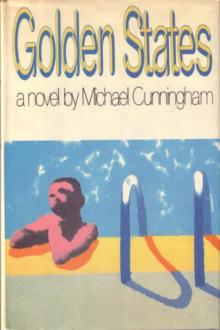- Home
- Michael Cunningham
Land's End Page 3
Land's End Read online
Page 3
The tidal pools, if it’s medium or high tide, will be full of minnows and little blue-black crabs. It is possible, though very rare, to see schools of squid that have gotten trapped by the receding tide and are waiting for the ocean to return. Squid alive are nothing like the ones in fish markets. They go opaque when they die. Alive, they are translucent, like jellyfish, and their eyes, though utterly unmammalian, are pale blue. When they swim, you see their eyes most clearly, and the spark of their tentacles.
Because this terrain is periodically submerged, you’ll find a good deal of what the ocean contains as you go along. The path is strewn with the bodies of crabs, which bleach to a freckled salmon color that they do not possess in life and ultimately to alabaster. You may see a dead bass or two, in the process of being picked clean by the gulls. You will see kelp and driftwood, sometimes in considerable piles, and you will see strands of rope torn from fishermen’s nets, black or yellow or turquoise or orange. I once found the end of a seagull’s wing out there, a harp of white feathers, and took it home to Kenny, glad not only to have happened upon such a thing but to be a man carrying a wing home to his lover, who would not be repelled by its gruesome beauty.
This walk, and the beach it leads to, is largely the province of gay men. As you near the beach and the dunes dwindle down into a broad, shallow basin, you’ll pass paths that meander out into the grass. They are dry at low tide. At high tide the water is as high as a man’s waist. These paths, this whole arena, is thoroughly populated on summer days—it is the Piazza San Marco of gay male Provincetown. Men walk to and from the beach. Men browse among the dunes, lounge on the small temporary islands that stand among the pools when the tide is in, wade or swim in the deeper parts. The paths that snake through the tall grasses form an elaborate series of mazes, and if you follow the paths at medium to high tide, you will find yourself up to your knees or waist in gently moving water surrounded on both sides by hedges of high grass. Men go into the grasses to have sex, and if you are uninterested in having sex with strangers or are bothered by the sight of other people doing it, you should avoid the grass maze and proceed directly to the beach, though even if you eschew the remoter reaches, you might pass two or more men sporting together, out in the open. In this bright, tidal landscape the men having sex always seem, at least to me, innocently bacchanalian—more creaturely than lewd. They seem to belong to a different version of the world, a more sylvan and semiclassical one, shameless and wild. They seem to have been freed from their labors and sorrows, their fears, even their hopes, and been given a summer hour or two in which desire is all that matters. I would be happy if the men who have sex in the salt marsh could be persuaded to wear fur leggings with hooves over their feet, attach little nubs of horns to their foreheads, and blow wistful tunes on pipes as they wander through the labyrinths of grass and water.
When you climb over the dunes that front on the ocean, you arrive at the beach, where the water is almost always calm, since Herring Cove lies on the inward curl of the Cape and faces southwest rather than east. By international standards Herring Cove is not much of a beach. It is relatively narrow, and the sand near the water is almost entirely covered with stones that are difficult to walk on. New England, even at its most sybaritic, usually involves some measure of challenge or inconvenience; it is not prone to dropping ripe fruit straight from the tree into your outstretched hand. The stones themselves are lovely, for whatever comfort that may offer. They are consistently smooth and oval, shaped by the water—the most symmetrical of them are like Noguchi sculptures. If you are inclined to pick up stones from the beach, I should warn you that many of them, when wet, appear to be fantastic shades of ochre or deep red or dark green, but they lose their color after they dry. I prefer the glossy black ones, which dry to various shades of gray, from yellow-gray to a satisfying milky gray like chalk erased from a blackboard. I keep a bowl of them on my desk.
The southern part of the beach, in summer, is full of men. You will see almost no one there who is not a man. Men lie on the sand in groups, talking and laughing, listening to music. They promenade, wearing very little, and some of them are beautiful, though the whole notion of strolling lithely and muscularly along the sand, looking to populate strangers’ dreams, is complicated by the stones, which effectively eliminate the possibility of maintaining regal composure for more than a few paces at a time. The whole business of cruising and being cruised at Herring Cove is a slightly comic one, very different from, say, the broad sandy highway of a beach at Fire Island, where ambitious objects of desire can saunter from east to west and back again as imperturbably as floats in a military parade.
If you walk along the beach to your left, you’ll get, eventually, to the Wood End lighthouse and, ultimately, out to Long Point. If you walk to your right, you’ll reach the beach’s official entrance, where the parking lot is. Close to the entrance is the women’s section.
The transformation is fairly abrupt. For some time you will have walked among men lying on towels (with a few of the braver specimens splashing around in the chilly water); then you will pass through a short intermediate strip of men mixed with women; and then the beach will be full, almost exclusively, of women.
It is considered a truism in Provincetown that gay men go to the beach with Speedos and a towel, while lesbians take as much as they can carry. One resists generalities (and is attracted to generalities), but it is undeniable that here, in the women’s section, you are much more likely to see folding beach chairs, umbrellas, coolers, inflatable rafts, rubber sandals for walking over the stones, and other appurtenances. The women arrayed on the sand here are, to roughly equal extents, domestic and Amazonian. As a man walking through their sector, I always feel that I’m in a foreign country—a Sapphic society every bit as strange and fabulous, and just as particular unto itself, as the tribes of satyrs roaming the watery paths in the dunes. Bare breasts are more the norm than the exception here, and for some of us it is a unique opportunity to understand that the female breast is among the more profoundly variable of human wonders. Here are women with breasts firm as pears. Here are women whose breasts are mere pale rises of flesh, more modest by far than the pectorals of most of the men lounging and romping just up the beach, with pert and defiant cantaloupe-colored nipples the size of fingertips. Here are women with majestic moons, tropically pink, marbled by traceries of blue-green veins, topped with low-lying, elliptical aureoles of creamy brown. The women in the women’s section are more likely than the men to be throwing balls or Frisbees at the water’s edge. They are more likely to be swimming with dogs. They are far more likely to have children, who are entirely absent in the men’s section. The women’s part of the beach is a welter of children, of all races, and there are more of them every year.
If you continue on, you will pass an unfortunate asphalt embankment—atop it is a snack bar, bathrooms, and showers. Farther still you will find yourself on a long stretch of beach dominated by straight families who have parked their campers or trailers and more or less settled in. Some of the campers and trailers have awnings, where grandparents sit in the shade admiring the view or reading or tending to barbecue grills. Men and women fish from the beach and often wait for a strike sitting on aluminum lawn chairs. Kids run all over the place. The people on this part of the beach are noisier, less sexual, more communal. The gay and lesbian sections are, to a certain extent, feudal—each encampment of friends and lovers and children and pets tends to regard only itself, to speak only to acquaintances as they pass, and to observe strangers either surreptitiously or not at all. While I’m certain that these straight families don’t know each other and probably don’t mingle, they require so much more space, with their campers and barbecues and fishing gear, their three or four generations, that turf lines are impossible to maintain. Compared with the gay men and lesbians up the beach, they are differently yoked into their lives. They are ostentatiously available to their spouses and parents and children, and so, to an outsider anyway, they s
eem more like a village, with all that villages imply about common purpose. It seems—though I don’t imagine this is literally true—that one mother will casually pluck another woman’s child from the surf, and that one grandfather will offhandedly flip the burgers of another man’s son as the two middle-aged boys in question reel in a bluefish.
Farther down the beach is Hatches Harbor, one of the lesser-known wonders of Provincetown.
HATCHES HARBOR
Although I am agnostic on the subjects of magic, earth spirits, and conscious but invisible forces, I can’t deny that several places in Provincetown possess some sort of power beyond their physical attributes. Hatches Harbor is one such place. It is some distance beyond the public beach, well past the outer reaches of the parking lot, so the only way to get there is by walking on the sand. It is, as its name implies, a natural harbor, a vulnerable point in the land mass where the ocean has curled its way in. It was once an estuary that extended inland for over a mile, but a dike built in the 1930s reduced it to a series of braided tidal channels.
Hatches Harbor is not well known. You are likely to find, at most, a few other people there, and you are at least as likely to be entirely alone. The harbor is dominated by an enormous sandbar that stretches across it like the broad back of a whale, albeit the placid, utterly smooth whale’s back you might find in a children’s book. To the north stands still another lighthouse, bigger than the other two in Provincetown, a serious lighthouse, tall and staunch, neither sweet nor toylike as the other two are, meant to warn big ships of true dangers. (Over the centuries at least a hundred ships have sunk in these waters.) Inland, directly behind you as you face the ocean, are dunes and scrub pine. None of this is especially dramatic or spectacular, not in the way of Delphi or the Oregon coast. Surf doesn’t crash against cliffs here, eagles don’t wheel in the sky. It has a spare and subtle beauty, more nearly related to parts of the New Mexico desert or the lakes of Finland. The harbor, the horizon, and the dunes are all in perfect proportion, visibly part of the same overarching idea. It has a way of gently insisting on the beauty of the small—look here, three round stones in a round cup of clear water. Like any proper mystery, it can’t be adequately described or explained. I can only tell you that it is a place of great tranquillity, and that if you go there and stay for an hour or longer, you may feel, when you walk back, that you’ve been farther and longer away than you have actually been.
THE DUNES
Behind the beach at Herring Cove, behind all of Provincetown, is the Cape Cod National Seashore, established during the Kennedy administration as a recreation area and nature preserve. Whatever our feelings about John F. Kennedy as president, we can be grateful to him for that. The town cannot expand past a certain point; no one can build a resort hotel in the dunes or on the ocean beaches. The dunes are an intact ecosystem, as particular unto themselves as Zion in Utah or the Florida Everglades, though unlike Zion or the Everglades they were formed, in part, by man. Early settlers felled the trees for fuel and lumber, and replanted the landscape with pitch pine and scrub oak. With the big trees gone, a sand-sea began working its methodical way in from the beaches, and what you are seeing in this sedate landscape is actually an ongoing process of erosion.
The best way to go through the dunes is on a bicycle, which you can rent from one of four places in town. A single snake of trail, not conspicuously marked, starts from the far end of the parking lot at Herring Cove and winds through the dunes. The dunescape is simultaneously verdant and lunar. It is dotted with brush and scrubby, stunted pine. It has a smell: pine and salt, with an undercurrent of something I can only describe as dusty and green. In patches the landscape is almost pure sand, pristine as sugar. The sandy areas seem primeval in their silence and shadows, though they are, of course, not ancient at all—they weren’t like this a hundred years ago; a century from now they will be visibly different. Still, I often feel when I’m out there that I’m palpably on the surface of a planet, with a thin illusion of blue overhead and the universe beyond. It is especially wonderful to ride through the dunes at night, when the moon is full.
In these same dunes but miles up Cape, too far for biking, is the place where Guglielmo Marconi first tested the telegraph—where a human being was able, for the first time, to send and receive wireless messages across the Atlantic. The building in which he conducted his experiment has since fallen into the ocean, but a weathered gazebo bearing a plaque stands today to commemorate the spot where, over a hundred years ago, Marconi sat day after day and night after night, convinced that he could communicate not only with those living on other continents but with the dead as well. He thought sound waves did not vanish over time; he believed he could find a way to hear the cries of men on ships sunk long ago, the voices of children whose own children were ancient by then, the musket reports of Columbus’s men as they showed the Tecumwah tribe what terrible new gods had arrived on their shores.
The Marconi Station, however, is a separate trip altogether, one that would require a car. This trail you’re on is merely a meandering, four-mile-long circle that takes you back, ultimately, to the East End of Provincetown. It offers only one choice, at roughly its midpoint. You can go straight ahead, through the beech forest and ultimately back to town, or you can turn left and ride out to Race Point.
RACE POINT
The beach at Race Point is, to my mind, superior to the one at Herring Cove, and I, who enjoy a beach full of gay men, have often wished my brothers had elected to colonize Race Point instead. Its sole disadvantage is the fact that it is several miles from town, and you can get there only on a bicycle or in a car. If you drive, you may very well find the parking lot full by ten A.M. on a summer day.
The beach at Race Point arcs north to northwest. It is more directly canted toward the open ocean than the one at Herring Cove, and so the water there is prone to do something more exciting than just plash quietly up against the sand. It has actual waves, though you’d have to go farther still, to the beaches of Truro and Wellfleet, before encountering anything that could be called surf. To get to the beach, you lope down a bank of dunes, on which patches of low grass have drawn windblown circles around themselves in the sand. The beach is broad and generous, at all tides, and not nearly so strewn with stones. Being less accessible, it is never as crowded as the beach at Herring Cove, and the people who go there are much more a mixed bag. You’ll find yourself among tourist families, townies with or without families, and the occasional renegade gay man or lesbian. It was at Race Point, several years ago, that we encountered a lesson in the mutability of desire, courtesy of Uncle Donald.
Kenny and I had gone with our friend Melanie to Race Point on an August afternoon (Melanie has a car) and put down our towels near a small family gathering. Beaches are, of course, perfect sites for eavesdropping, and as we lay in the sun, we quickly discerned the following about our neighbors. They were a handsome, dark-haired Englishwoman, her American husband, their five-year-old son, and the woman’s gay younger brother, Donald. We knew his name was Donald because the little boy, transported by love, said “Uncle Donald” whenever it was called for and sometimes when it was not. Uncle Donald was a lithe man in his early thirties, wearing blue Speedos. He was wonderful with the child. They played together in the water, played in the sand; Uncle Donald was patient if ironic about the child’s endless assertion of suddenly devised games with arcane and elaborate rules. When Uncle Donald reached his limit, they lay down together on his towel. The boy announced that Uncle Donald was his mattress, sprawled on top of him, and fell asleep. Uncle Donald teased his sister, who teased him back. The phrase “looking for love in all the wrong places” was mentioned. In repose, with a slumbering child on his stomach, Donald might have been carved from pale pink marble. His lean, compact body was hairless except for two light-brown tufts in his armpits. His face, in profile, was angular, with a potent brow and a firm jut of chin. Kenny and I agreed, in whispers, that we wanted him and wanted, with roughly equivalent ar
dor, to be him. Melanie declared her willingness to give up women, at least for a while. Donald was wry and kind; innocently virtuous the way a prince might be if princes ever managed to live unashamedly among fountains and marbled halls, so adored that they returned adoration automatically, as a matter of course, because they had known nothing else.
Less than an hour later the little extended family prepared to leave. We watched, surreptitiously, as Uncle Donald woke the child, set him on his feet again, stroked his hair. We watched then as Donald put on baggy chinos and a polo shirt, as he plopped a dramatically unflattering canvas hat on his head. Standing, in clothes, he slouched. They departed, with the child scampering and cavorting around the object of his affections, who had by then transformed himself into a citizen in poly-blends; a regular guy, unenchanted, with ordinary features (we saw, once he was dressed, that he in fact had a pleasant but unremarkable face, with too much chin for its modest nose and too much forehead for its close-set eyes); someone you wouldn’t glance at twice on the street. He went off (I imagine) to join the multitude of others cruising the streets or nursing beers in the semidark at the edges of dance floors; off to hope and wish and wonder; to admire the flashier guys dancing shirtless or laughing heedlessly with their packs of friends; to try his luck along with everybody else who was out there, the whole wistful, unruly crew, looking for love in all the wrong places.
THE BEECH FOREST
If you go straight on the dune trail and skip Race Point, you will eventually reach the beech forest. There is a clear point of demarcation between the sand and the woods it has partially engulfed. First you will see what appear to be outcroppings of bare twigs protruding from the sand—these are the tops of dead trees. Several yards farther on you will see dead trees mired to their lower branches in sand, and then trees that are covered only halfway up their trunks, still alive but beginning to die. Then you will be among the living trees. The sand-glacier in the beech forest has been more or less halted by conservationists, but the dunes north of the forest remain in motion. On old maps you can locate buried forests, and walk across pristine dunes with deceased forests inside them.

 The Hours
The Hours Land's End: A Walk in Provincetown
Land's End: A Walk in Provincetown Golden States
Golden States A Wild Swan
A Wild Swan A Home at the End of the World
A Home at the End of the World Flesh and Blood
Flesh and Blood Specimen Days
Specimen Days Land's End
Land's End By Nightfall
By Nightfall Hours
Hours